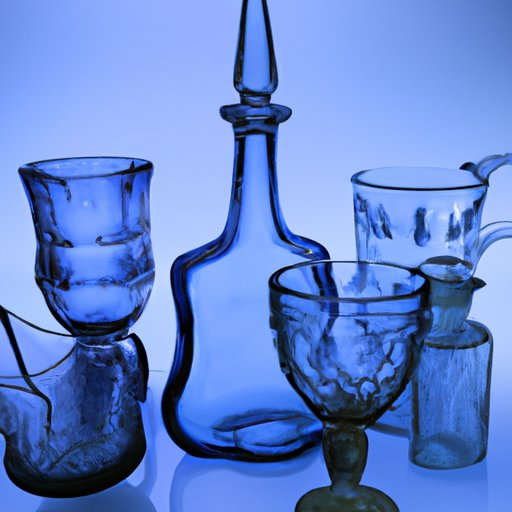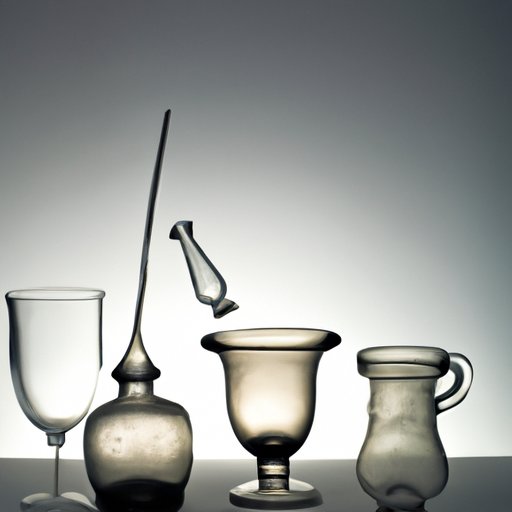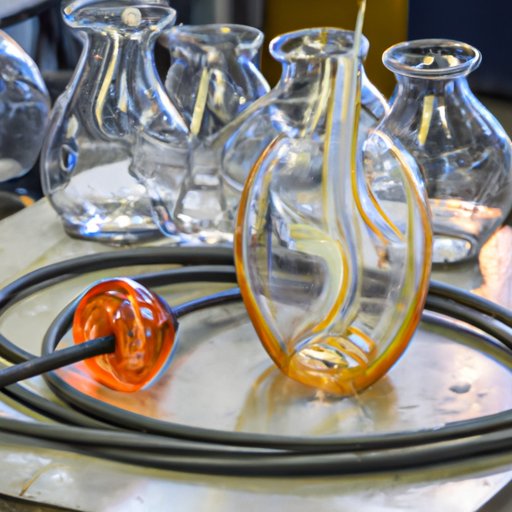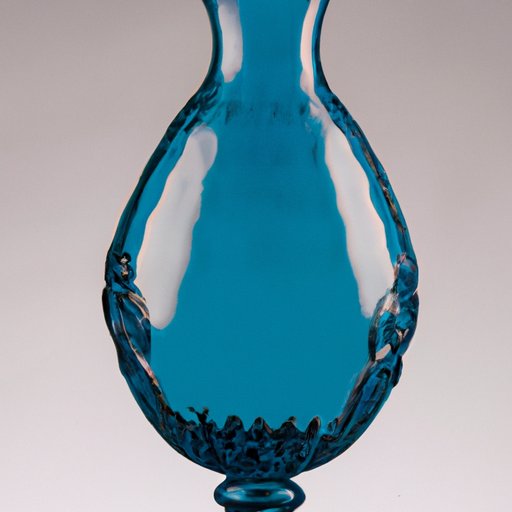Introduction
Glassware refers to objects made of glass, such as drinking glasses, bowls, vases, and plates. The invention of glassware has had a profound impact on societies throughout history, allowing people to craft beautiful objects that are both useful and aesthetically pleasing. This article will explore the history of glassware, from its invention in ancient times to its development in modern society.

A History of Glassware: Exploring the Invention of Glassware
The invention of glassware can be traced back to ancient times when glassmaking was first developed. Early glassmakers used rudimentary tools and methods to create objects out of molten glass. Over time, these techniques have been refined and improved, leading to the production of high-quality glassware.
Overview of Early Glassmaking
Glassmaking is an art form that has existed since at least 3000 BC. It is believed that the earliest forms of glass were created accidentally by ancient peoples who heated sand and other materials together in order to create ceramic vessels. These early experiments led to the discovery of glass, which is essentially a liquid solidified into a solid state.
Discoveries in Ancient Egypt
In Ancient Egypt, glassmaking was further developed and refined. Glass objects were used for decorative purposes, such as jewelry and figurines. Egyptian craftsmen also used glass to create intricate wall decorations and even small vessels. By the fifth century BC, glassblowing had been invented, allowing for the mass production of glass objects.
Development of Techniques in Mesopotamia
Mesopotamia was another major center of glassmaking activity. Craftsmen in this region developed new techniques for manipulating glass, such as cutting, engraving, and coloring. They also experimented with different types of glass, including colored, stained, and enameled glass. These innovations allowed for the creation of more complex and detailed glass objects.
The Art of Glass: Tracing the Origins of Glassware
As glassmaking techniques spread across the world, different cultures began to develop their own styles of glassware. From Ancient Rome to Islamic craftsmen, each culture added its own unique touches to the art of glassmaking.
Production in Ancient Rome
Ancient Romans were among the first to produce glassware on a large scale. Roman craftsmen developed a variety of techniques for producing glass objects, such as blowing, casting, and stamping. They also experimented with different colors and designs, creating beautiful pieces of art.
Spread of Glassmaking Across Europe
As the Roman Empire expanded, glassmaking spread across Europe. In the Middle Ages, glassmakers in Germany and Italy developed new techniques for producing glassware, such as cutting and engraving. By the 16th century, the craft had become so popular that glassmakers had set up workshops in many European cities.
Influence of Islamic Craftsmen
Islamic craftsmen also had a significant influence on the development of glassware. During the Middle Ages, Islamic glassmakers developed new techniques for coloring and decorating glass. They also introduced new shapes and designs, such as intricate patterns and calligraphy. These innovations helped to make glassware more beautiful and desirable.

Through the Ages: A Timeline of Glassware Invention
As glassmaking evolved over time, different regions of the world developed their own distinct styles of glassware. From Venetian glass to American production, each era of glassmaking has contributed to the development of modern glassware.
Emergence of Venetian Glass
Venetian glassmakers played a major role in the development of glassware. During the Renaissance, Venetian craftsmen perfected the technique of glassblowing, allowing them to produce intricate and delicate pieces of glass. They also developed new techniques for coloring and decorating glass, creating beautiful works of art.
Growth of British Glassmaking
British glassmakers began to emerge in the 17th century. They developed new techniques for cutting and engraving glass, creating pieces of exquisite beauty. By the 19th century, British glassmakers had become renowned for their skill and craftsmanship.
Expansion of American Production
In the late 19th century, the American glass industry began to expand. Companies such as Corning and Libbey established factories that produced high-quality glassware. This period saw the introduction of new technologies, such as machine-made glass and the use of molds for mass production.
Ancient Innovations: Uncovering the Beginnings of Glassware
The invention of glassware can be traced back to ancient times when glassmakers began experimenting with different techniques and materials. These early innovations laid the foundation for the production of modern glassware.
Introduction of Blowing and Casting Techniques
One of the most important innovations in glassmaking was the invention of glassblowing. This technique allowed glassmakers to shape molten glass into intricate forms. Glass casting was also developed, allowing glassmakers to create hollow objects such as bowls and vases.
Advances in Coloring and Decoration
Glassmakers also experimented with different techniques for coloring and decorating glass. They developed new methods for adding color to glass, such as the use of enamels and stains. They also experimented with different shapes and designs, creating beautiful pieces of art.
Development of Stained and Cut Glass
In the Middle Ages, glassmakers in Europe developed new techniques for working with glass. They perfected the technique of cutting glass, allowing them to create intricate patterns and designs. They also developed the technique of staining glass, which allowed them to add a range of vibrant colors to their glassware.

Crafting Beauty: Examining the Start of Glassware Production
Modern glassware production has its roots in the innovations of ancient glassmakers. Over the centuries, glassmakers have continued to refine and improve their techniques, allowing them to create beautiful and functional pieces of glassware.
Introduction of Industrialization
The introduction of industrialization in the 19th century revolutionized the glassware industry. Companies such as Corning and Libbey began to mass-produce glassware using machines. This allowed them to produce large quantities of glassware at a lower cost and with greater efficiency.
Proliferation of Machine-Made Goods
The proliferation of machine-made goods in the 20th century led to a decline in the quality of glassware. This period saw the emergence of mass-produced glassware that lacked the craftsmanship and beauty of handmade pieces. However, some companies still produced high-quality glassware, such as Steuben Glass in the United States.
Rise of Modern Designers
In recent decades, a new generation of glass designers has emerged. These designers have embraced traditional techniques, such as hand-blown glass and intricate engraving, while also incorporating modern design principles. These modern designers are creating beautiful and unique pieces of glassware that reflect contemporary trends.
Conclusion
The invention of glassware has had a lasting impact on societies around the world. From the earliest experiments in Ancient Egypt to the advances of modern designers, the history of glassware is filled with innovation and creativity. Through the centuries, glassmakers have developed new techniques and materials, allowing them to create beautiful and functional pieces of glassware.
From its humble beginnings in ancient times, glassware has come a long way. Today, glassware is an integral part of our lives, from everyday drinking glasses to elaborate works of art. Its invention has changed the way we interact with the world and continues to influence the way we live today.
(Note: Is this article not meeting your expectations? Do you have knowledge or insights to share? Unlock new opportunities and expand your reach by joining our authors team. Click Registration to join us and share your expertise with our readers.)
